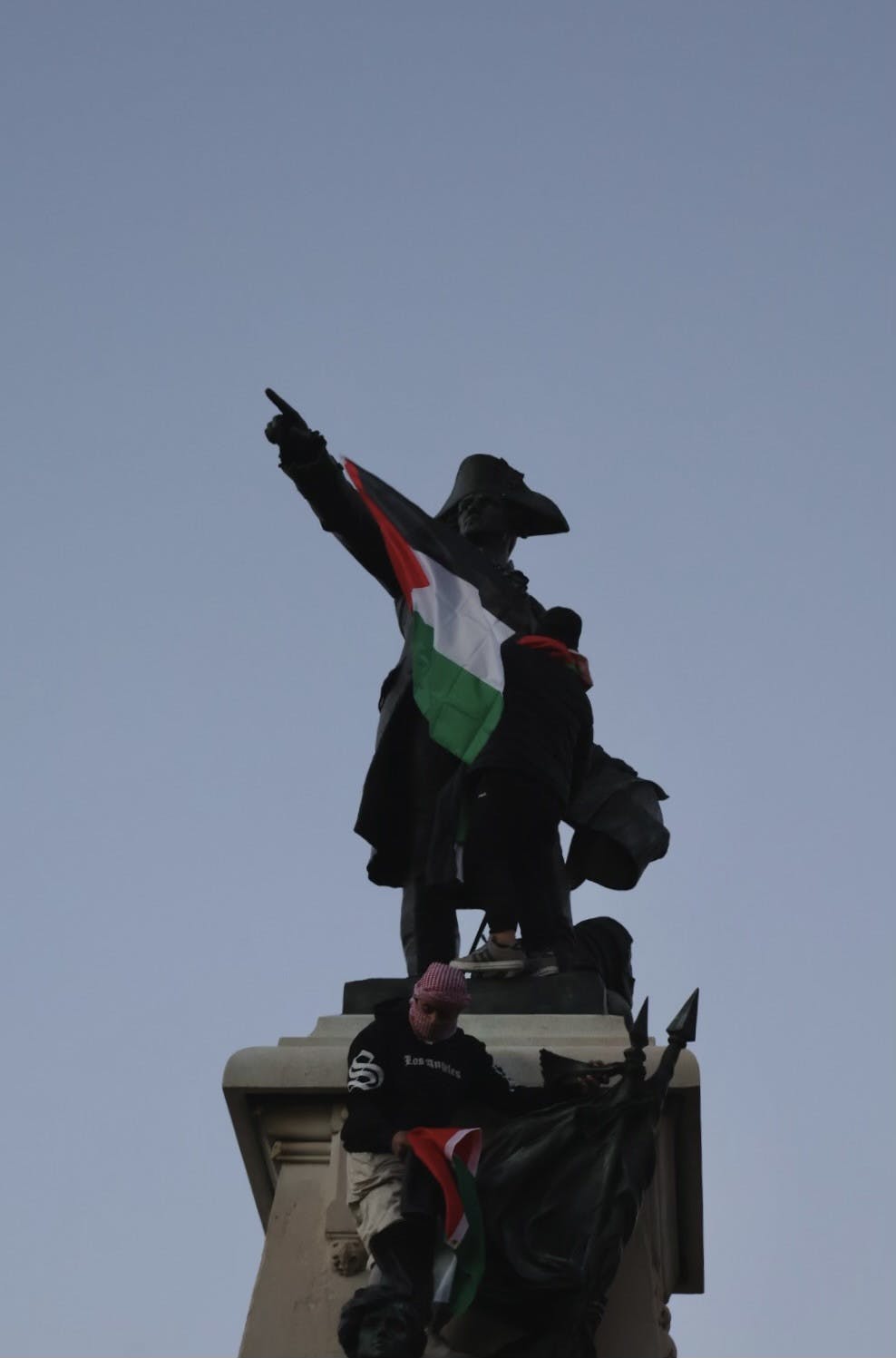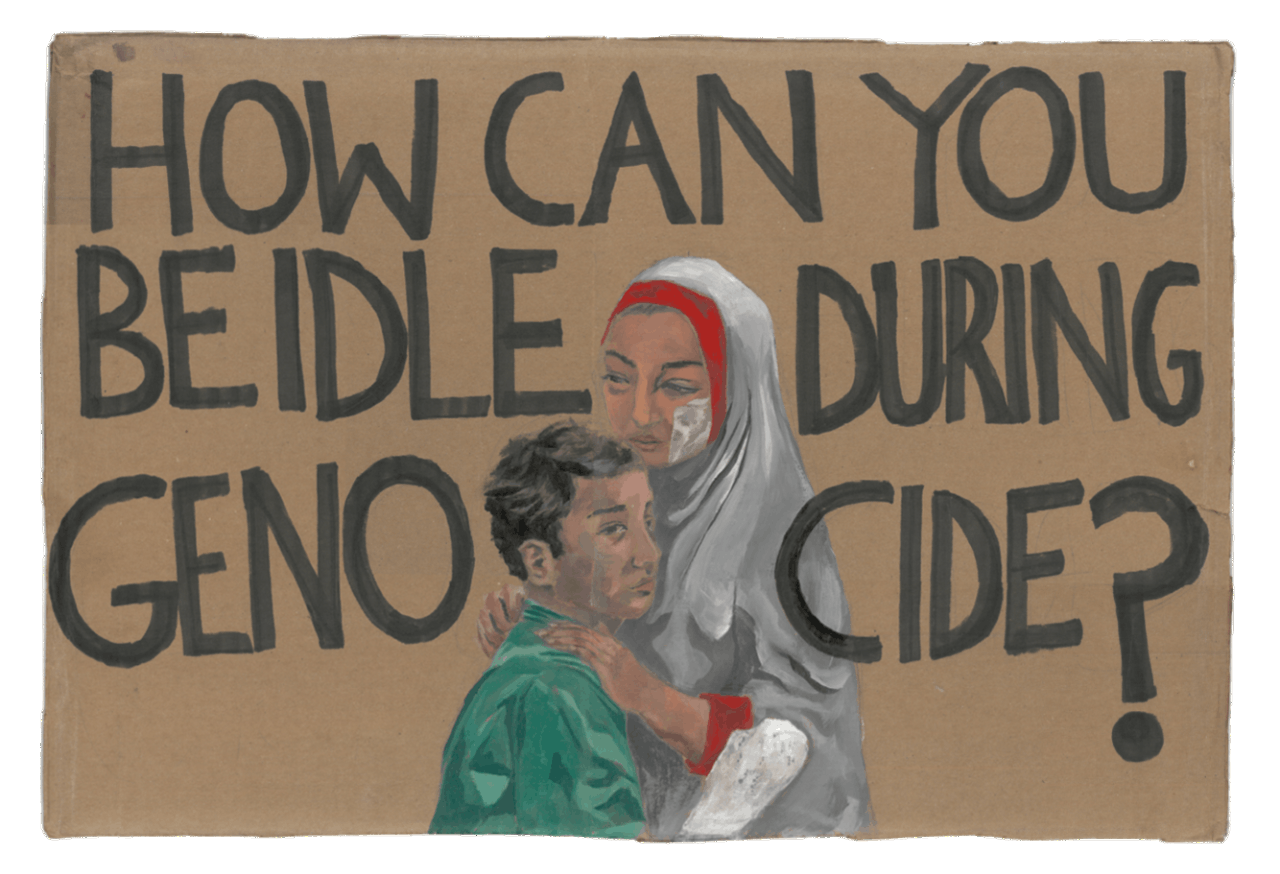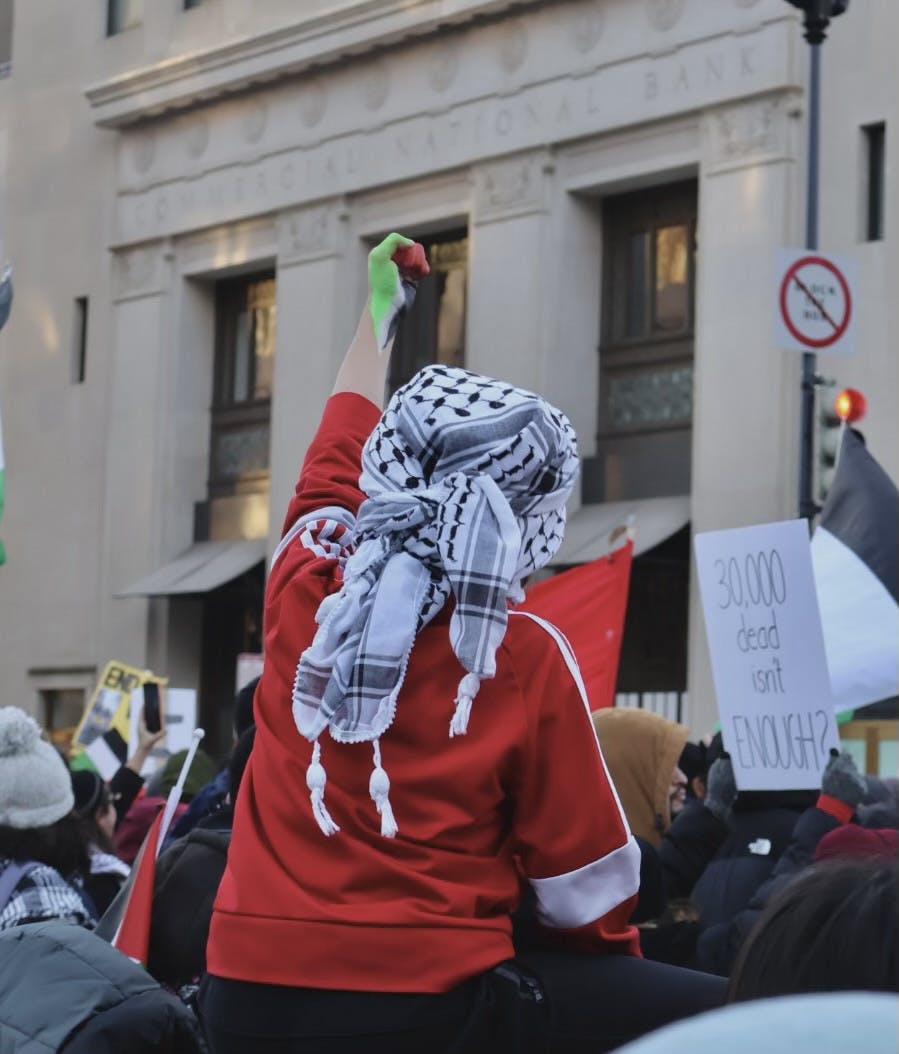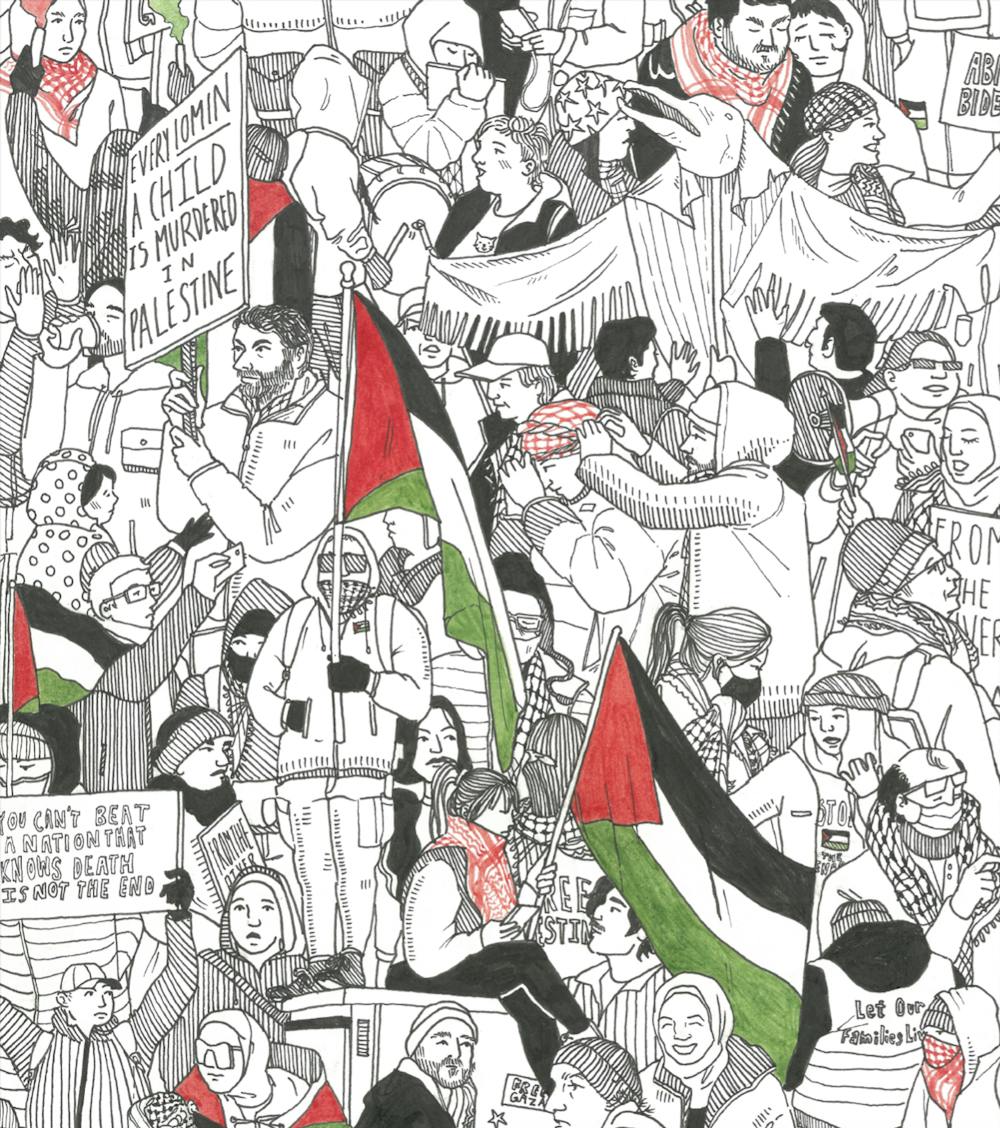Crossing a bridge over the Chesapeake Bay on our nine hour drive from Middlebury down to Washington, D.C., our car of five turned and spotted the distinct newspaper-pattern of a keffiyeh whipping out of a neighboring car’s open window. They had most likely seen our own keffiyehs as they passed by. Instantly, a connection was made between strangers all intending to confront our nation’s leaders over continuing to fund Israel’s genocide with our tax dollars. It was January 13th and the weekend of 100 days of war in Gaza, an anniversary marked by international protests taking place in D.C., London, Rome, Paris, Dublin, Johannesburg, South Africa, and Kuala Lumpur, Malaysia. We, three Middlebury first years, could not miss this momentous event despite the 500 mile distance from rural Vermont to the shining capital of the American empire.
Soon we reached the D.C., driving past crooked brick townhouses and shops, with the shining obelisk of the Washington Monument speared over the skyline. Upon entering a tunnel leading into downtown, a strangely harmonized car-horn symphony crescendoed up from traffic. Against the wall of the tunnel, young masked men were sweeping a huge Palestinian flag to and fro, pumping their fists.
Netanyahu, you can’t hide! You’re committing genocide!
Gaza Gaza don’t you cry, Falastin will never die!
An enormous turnout of protesters, organized by the American Muslim Task Force for Palestine and associated groups, swarmed the sidewalks on the way to Freedom Plaza. Street vendors sold Palestinian flags, and women prayed on their knees outside a Macy’s. By the time we got to the beginning of the route, tens of thousands had convened for the March for Gaza rally, listening to the speakers on a stage obscured by people of all generations. Lamp posts and stone steps were mounted by people wielding large flags, signs and loudspeakers, inciting chants that the crowd below echoed.

We spoke to several small groups gathered at the protest, including a trio of students from a university in New Jersey. They shared that the administration banned their Students for Justice in Palestine (SJP) chapter and failed to address online hate from pro-Israel students who claimed the peaceful protesters were armed, describing them as “LOCKED AND LOADED.”
Despite the dismal environment on their college campus, the three students, Wisam, Muaz and Tasha, felt that support for Palestine has been persistent and growing. “They keep saying we're gonna forget, we're gonna forget, and it's January, and this is way bigger than the first time. Way bigger, way more organized. And it's crazy. No one's lost any connection to Palestine or anything. It's beautiful,” Wisam said.
Jude, a 19-year-old protester originally from Bethlehem, West Bank, expressed excitement about the massive growth of American support she has witnessed in the past year. “Two years ago you, walk up to an average American, they can't even tell you where Palestine is located. And now half the world knows what Palestine is, knows what's going on, and is standing up for my country,” Jude said.
Other protestors shared their stories of resistance too. As we weaved our way towards the stage, where 2024 presidential candidate Cornel West was delivering his passionate speech, we struck up a conversation with two young men laughing with each other. With sturdy posture and confident recounting of their pro-Palestinian organizing, the pair seemed experienced. We were surprised that both protestors were only in high school. Samer, 17, recounted both victories and setbacks in his efforts.
“I run our MSA [Muslim Students’ Alliance]. And we've had quite a bit of posters and events to start off fundraisers. We've raised $400 so far. The administration has been taking down certain signs without showing support, but we got the principal to take a picture with some of the signs.”
When asked what motivated them, the students recounted their personal ties with Gaza. Yamin, also 17, said he witnessed multiple kids dying when he was in Palestine last summer.
“My cousin was shot, and now is paralyzed from the waist down. So that gets me more riled up to come out and support.”
With a straight face, all remnants of the lightheartedness Samer and Yamin had previously exhibited disappeared.
Samer shared his own horrific experience. “A life is a life. It's not just a number lost. And I've had family for many years being killed in the occupation and being put in prison for no reason. And they're suffering for no, for no honest reason. And it triggers me because we can't do anything except come out here. But seeing all 600,000 people that are expected to come to the show out means all that it means.”

Speakers such as the executive director of the Council on American-Islamic Relations Nihad Awad, former State Department official Josh Paul and several Palestinians with family lost in the conflict continued to rally the crowd. While they spoke, we met Omar, a 54-year-old Palestinian man who immigrated to the United States in 1990 after the First Intifada. Frustrated and beaten down by Israeli military occupation in the West Bank and Gaza, tensions boiled over when a car driven by Israel Defense Forces soldiers killed four Palestinians from the Jabalia Refugee Camp. Militant protests continued for three years from 1987–1990.
Omar pointed out the accessibility of the truth in this modern era of technology, referring to the widespread, real-time online documentation of what is actually going on in Gaza.
“And you don't have to be some intelligent or, or some analyst to know the truth. The truth is right there. Just you have to move and transport yourself to there and you will see all the apartheid, you will see all the injustice,” Omar said.
After about an hour of standing in the windy Freedom Plaza, the mass began to move. The road was wide, and the crowd filled it from curb to curb on our 1.4 mile route to the White House. We would soon learn that over 400,000 people were there, making it the largest pro-Palestine protest in the U.S. to date.
A huge projection flashed on the side of a nearby building: a photo of Joe Biden’s face complete with vampire fangs and a caption reading, GENOCIDE JOE! Boys formed a ladder-like arrangement up the Rochambeau Statue near the White House gates, jamming Palestinian flags through the openings in the bronze monument as people cheered them on. Red and green smoke funneled into the air above us. Protesters made red handprints on the sandy granite columns lining the main gate of the White House, which protesters began to shake, though did not breach.
The blocky white building sat safely behind an iron gate, a great green lawn, hedges and a giant fountain. Towering white paper-mache birds with tattered cloth wings were propped up on wooden dowels, surveying the crowd. Created by the Bread and Puppet Theater of Glover, Vt. in the Northeast Kingdom, the birds’ ghost-like presence represented a mood of grief for over 25,000 people murdered since October in Gaza.
Since the most recent war began, people previously unfamiliar with the issue have been engaged in the movement sweeping the globe aiming to stop the genocide of Palestinian civilians, a large percentage of whom are children. On the drive back, we discussed how our conversations with protestors who openly shared their personal ties to this war moved us deeply. The pulsing, visceral spirit of 400,000 protestors, all focused on the same cause, left us with a hope that change is coming; persistent momentum will bring the day in which the people of Palestine are able to live on their land in peace.

June Su '27 (he/him) is the Senior Multimedia Editor.
June is a political science major and studio art minor, also studying history and Spanish. He spent the summer of 2025 working as a political science research assistant examining investments in the Congo River Basin to achieve international biodiversity and carbon goals.




